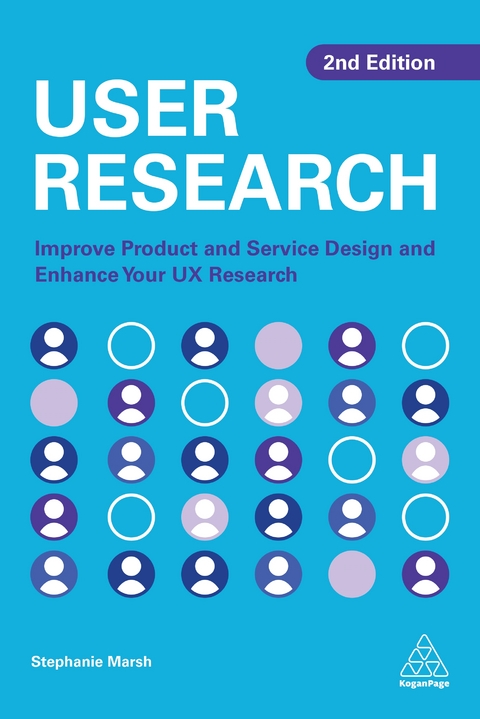
User Research
Kogan Page Ltd (Verlag)
978-1-3986-0357-8 (ISBN)
Despite businesses often being based on creating desirable experiences, products and services for consumers, many fail to consider the end user in their planning and development processes. This book is here to change that.
User experience research, also known as UX research, focuses on understanding user behaviours, needs and motivations through a range of observational techniques, task analysis and other methodologies. User Research is a practical guide that shows readers how to use the vast array of user research methods available. Written by one of the UK's leading UX research professionals, readers can benefit from in-depth knowledge that explores the fundamentals of user research.
Covering all the key research methods including face-to-face user testing, card sorting, surveys, A/B testing and many more, the book gives expert insight into the nuances, advantages and disadvantages of each, while also providing guidance on how to interpret, analyze and share the data once it has been obtained. Now in its second edition, User Research provides a new chapter on research operations and infrastructure as well as new material on combining user research methodologies.
Stephanie Marsh (she/they) is a leading UX research professional and currently UX Research Operations Lead at Springer Nature. They are the former Head of User Research and Analysis for the UK Government Digital Service and former Head of Digital Strategy for the UK Ministry of Defence. She was also previously a consultant at Bunnyfoot, a leading UX consultancy in the UK. They have contributed chapters to a range of peer-reviewed texts in related fields and has delivered talks on UX Research, Research Operations and UX strategies at a range of conferences and industry events. She is based in London.
Chapter - 01: Introduction: Why is user research so important?
Section - ONE: The fundamentals: What good research looks like
Chapter - 02: Planning your user research
Chapter - 03: Best practice in user research: Who, what, why and how
Chapter - 04: Getting the legal and ethical stuff right
Chapter - 05: Setting up for success
Chapter - 06: Managing user research logistics: agencies, facilities and contracts
Section - TWO: Selecting and using user research methods
Chapter - 07: Usability testing: observing people doing things
Chapter - 08: Content testing: what do people think your content means?
Chapter - 09: Card sorting: understanding how people group and relate things
Chapter - 10: Surveys: how to gauge a widespread user response
Chapter - 11: User interviews: understanding people's experience through talking to them
Chapter - 12: Diary studies: how to capture user research data over time
Chapter - 13: Information architecture validation through tree testing: does the structure of your information work for your users?
Chapter - 14: Ethnography: Observing how people behave in the real world
Chapter - 15: Contextual inquiry: Interviewing people in their own environment
Chapter - 16: A/B Testing: A technique to compare different options
Chapter - 17: Getting the best out of stakeholder workshops
Chapter - 18: Guerrilla research: Running fast-paced research in the real world
Chapter - 19: How to combine user research methodologies
Section - THREE: Analyzing user research data
Chapter - 20: Content analysis: understanding your qualitative data
Chapter - 21: Identifying themes through affinity diagramming
Chapter - 22: Thematic analysis: Going beyond initial analysis
Chapter - 23: Agile analysis
Chapter - 24: Analysing usability data and cataloguing issues and needs
Chapter - 25: Analysing data to create personas to communicate user characteristics and behaviour
Chapter - 26: Analysing data to create mental models: visualizing how users think and identify opportunities
Chapter - 27: Turning findings into insights
Chapter - 28: Making recommendations: How to make your research findings actionable
Chapter - 29: Creating executive summaries and detailed reports to present results
Chapter - 30: Using video playback to present your research results
Chapter - 31: Using journey and experience maps to visualize user research data
Chapter - 32: Using scenarios and storyboards to represent the user journey
Chapter - 33: Using infographics to translate numerical and statistical data
Chapter - 34: How to recommend changes to visual, interaction and information design
Chapter - 35: Conclusion
Section - FOUR: UX storytelling: Communicating your findings
| Erscheinungsdatum | 24.01.2022 |
|---|---|
| Verlagsort | London |
| Sprache | englisch |
| Maße | 155 x 235 mm |
| Gewicht | 505 g |
| Themenwelt | Informatik ► Datenbanken ► Data Warehouse / Data Mining |
| Wirtschaft ► Betriebswirtschaft / Management ► Marketing / Vertrieb | |
| Wirtschaft ► Betriebswirtschaft / Management ► Unternehmensführung / Management | |
| ISBN-10 | 1-3986-0357-0 / 1398603570 |
| ISBN-13 | 978-1-3986-0357-8 / 9781398603578 |
| Zustand | Neuware |
| Informationen gemäß Produktsicherheitsverordnung (GPSR) | |
| Haben Sie eine Frage zum Produkt? |
aus dem Bereich


